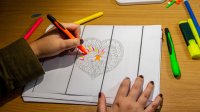Helping Students Cope With a Difficult Year
These tips on supporting emotion regulation and building strong relationships will help students next year and beyond.
Your content has been saved!
Go to My Saved Content.As students return to the classroom after over a year of remote and hybrid learning, loss and trauma are ongoing themes. As many as 43,000 children have lost a parent to Covid-19. Lockdowns and quarantine meant social isolation, which has resulted in increases in depression and anxiety in children and adolescents. Moreover, since schools can be a stabilizing force in many children’s lives, switching from in person to remote to in person again can add stress.
These unresolved traumas can affect memory and concentration, putting students at risk for lowered levels of academic performance. Teachers—many traumatized themselves—are on high alert for students who show signs of trauma, like difficulty sitting still, irritability, emotional volatility, and difficulty regulating their emotions, plus withdrawal, avoidance, and constant fatigue.
In the face of widespread trauma, strategies rooted in emotional regulation, self-growth, and relationship building can help students heal from stress and loss.
Emotional Regulation
Foster emotional expression through creative outlets: Provide students with the opportunity to engage in creative outlets such as art, music, or writing. Let them freely express their emotions and help process any built-up frustrations or stress. Sometimes that requires making time for therapeutic art activities such as constructing masks or collages or having students respond to prompts in creative ways related to the curriculum such as a reflection on a topic in ELA or social studies. Questions like “What advice would you give a character/historical figure?” and “How do your challenges or stressors compare to or differ from those of a character/historical figure?” are relevant and can prompt deep reflection.
Conduct daily mood check-ins with students: Asking students to assess their mood helps them learn how to identify their emotions and helps teachers quickly assess students who may need some additional support before they are ready to learn. Consider using a ready-to-learn scale in which students rate their emotions from 1 to 10, with 1 to 4 representing down emotions of tiredness or sadness, 5 to 7 representing feeling settled and ready to learn, and 8 to 10 representing up energized emotions or even hyperactivity.
If students are on the down or up end of the scale, direct them to try self-regulation strategies such as taking a movement break or doing some deep breathing to help shift them to the ready-to-learn zone. Other check-in ideas include having students describe how they are feeling with one word or through the use of metaphors such as weather. A great way to wrap up the daily mood check-in is by asking students, “What do you need from your peers and teachers to help you be your best self today?”
Create a calm corner in the classroom: Students who feel overwhelmed often benefit from a designated area where they can go to manage their emotions or work independently without having to leave the classroom. Create a separate space equipped with self-regulation tools like coloring worksheets, play dough, or stress balls. A comfy chair, a helpful poster, and directions for bubble breathing can also help settle the mind.
Self-Growth
Ask students to write letters to their past selves: Provide students with writing prompts like these:
- “What do you wish you knew prior to the Covid-19 pandemic?”
- “What advice would have made this past year better for you?”
- “What do you want your future self to remember about this time in your life?”
Reflective prompts like these encourage students to acknowledge challenges and brainstorm solutions for managing their struggles.
Focus on student growth: We typically focus on the negatives when we’re stressed, so it’s important to maintain a growth mindset. By highlighting areas where students have grown, teachers can focus on the positives and acknowledge how challenging times present opportunities for learning. Asking students what they have learned about themselves in the past year encourages students to engage in self-reflection.
Relationship Building
Encourage students to share about themselves: Try starting each day with an expression of gratitude when you and your students share something or someone you’re thankful for, or conclude the day by sharing something enjoyable about the day. You can also try the think-pair-share model and have students share with partners descriptions of their hero, the place where they are happiest, or a favorite memory. Other ideas include nominating students to share a daily laugh such as a joke, story, or meme with the class.
Focus on fun: Plan time for a favorite card or board game as a brain break. Uno is always a student favorite, and cribbage can help reinforce math skills. You can also gamify lessons by having students earn badges through completing learning challenges or having students take on different roles to reenact certain perspectives or historical events. Movement through scavenger hunts, wellness walks, quick dance parties, or yoga gives students’ brains a break and offers opportunities for students to have fun.
Engage in collaborative learning: Collaboration among students not only fosters healthy relationships but also encourages students to learn from each other and further their understanding of the material. Some great examples of collaborative learning include group problem-solving; using the jigsaw method, where each student is given a task or problem to solve and then teaches the other members of the group; and engaging in small group tasks such as creating a commercial.
